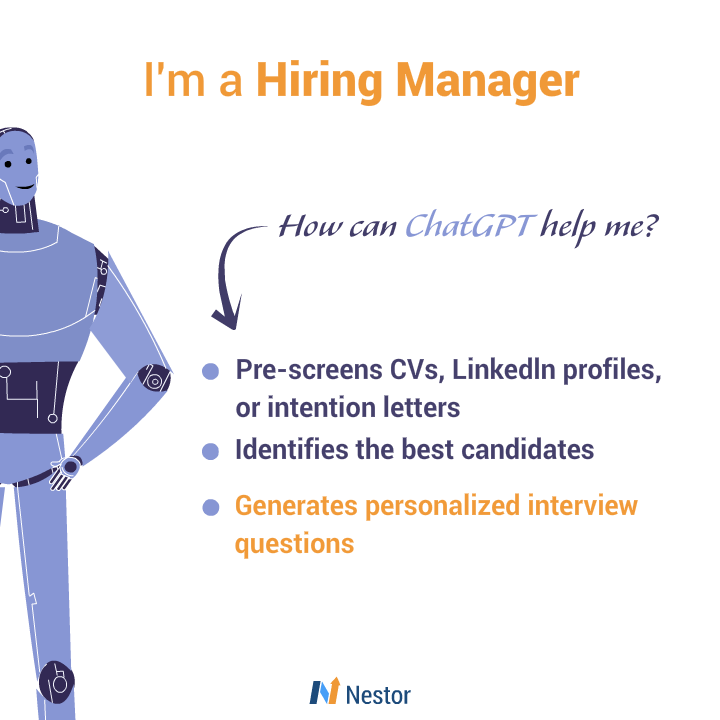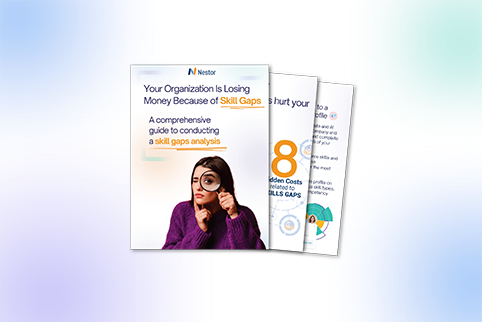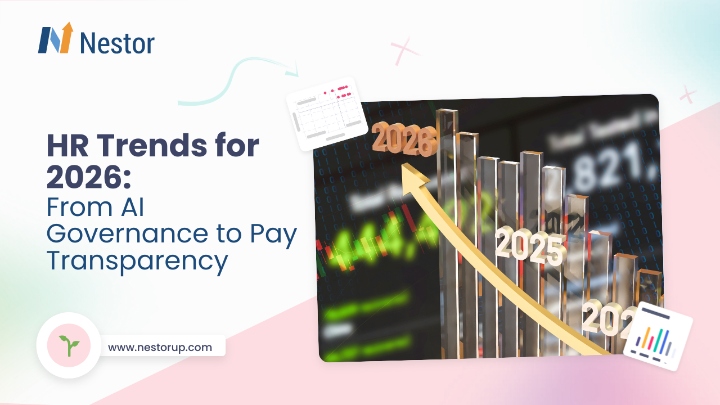
Over the years, AI tools have expanded their reach and applications across a variety of industries and processes, proving their positive impact on efficiency and productivity. HR operations are no strangers to AI, as these tools have streamlined recruitment, onboarding, training, and ongoing workforce analytics processes. But now a new question has emerged: what are the best use cases of ChatGPT in HR in this next chapter of work?
ChatGPT, the creation of OpenAI, has opened up a whole new set of possibilities, which weren’t available before. And HR departments should keep their minds open and see how they can successfully implement this new technology for the benefit of the company, the workforce, and their own.
It all starts with understanding what ChatGPT is, what it can and cannot do, and how it can make life easier for Human Resources leaders.
What is ChatGPT?
ChatGPT is an AI-based tool that processes natural language and provides answers in human-like written interactions. This large language model (LLM) can do various things, including:
- answer questions
- summarize information
- create different types of texts
- translate
- write code
ChatGPT is also the fastest-growing application of all time, having reached 100 million users in the first 2-3 months after its launch. To put it in context, it took Gmail 5 years and Facebook around 48 months to achieve the same adoption rate.
For now, we’re in the research phase and ChatGPT is free to use. But this might change going forward. For example, from February 1 there’s already a pilot subscription plan called ChatGPT Plus starting at 20 USD per month (at the time of writing this article).
How is ChatGPT different from other generative AI tools?
The main differences between ChatGPT and other similar bots are:
- The ability to remember previous prompts and requests. This allows it to have human-like conversations with users.
- The ability to admit being wrong. When presented with new information that challenges its answers, ChatGPT can — but doesn’t always — admit its mistakes.
- Challenges false or incorrect premises. OpenAI’s bot will try to provide factual information when faced with false premises.
- Deny inappropriate requests. ChatGPT is programmed to refuse to answer controversial topics or follow harmful instructions.
ChatGPT in HR: applications across various Human Resources functions
While it’s still early on, there are numerous ways in which ChatGPT can and already is used by managers and employees everywhere. From writing email responses to summarizing large notes, the potential impact in the workplace is there to be seen by everybody.
But how could HR specialists use this chatbot to improve their work and companies?

Recruitment & hiring
The hiring process can be a lengthy and resource-consuming activity for any HR department. At the same time, it is one of the most important activities that directly contribute to the long-term success of any organization.
Here, ChatGPT could help by taking over some of the steps in the process. For example, it can help with the content creation for job descriptions, pre-screen CVs, LinkedIn profiles, or intention letters. Further on, it can create candidate profiles and use the job criteria and expectations to quickly identify the best candidates for the role.
Once the interviewing stage begins, OpenAI’s bot can create personalized interview questions based on the candidate’s previous experience. This would help HR specialists save time and ask each job applicant more relevant and insightful questions.
Learning and development (L&D)
ChatGPT’s features can make it a helpful assistant in the active development of any employee within your company. Thanks to its ability to be trained on new and specific data, it can support growth in various ways:
Generate personalized learning plans & materials
ChatGPT can suggest learning resources based on the individual needs of each worker. That way, your workforce will have the opportunity to develop the right skills at the right time and enjoy a successful career.
The bot can also generate personalized learning materials after identifying the corresponding learning objectives. These personalized materials will include relevant insights from different sources and will meet the individual needs of a particular employee.
Summarize courses and learning materials
The ability to summarize information and data efficiently can make ChatGPT the ideal learning partner in the workplace. It will help employees save time and focus on the most relevant learning objectives from their educational materials.
Create and evaluate quizzes from courses
Not all courses include quizzes or (self) evaluation methods. Here’s where ChatGPT can once again make life easier for employees and HR departments. It can analyze entire courses, generate questions and evaluate your employees’ test answers.
Act as a virtual teaching assistant
Thanks to its ability to remember previous requests and conversations, ChatGPT can truly become a personal trainer or virtual assistant in the teaching process. This ability is more or less a combination of the previous features above, which, if implemented well, would transform the way employees learn and grow at work.
Performance evaluation & pay increase
With the use of ChatGPT or similar models, HR specialists and people managers would have a much easier job with performance reviews, feedback loops, and salary increases (and amounts).
That’s because the bot can quickly and easily scan large data sets of salary levels, and analyze benchmarks and expectations across different departments, companies, or even areas. Combined with its ability to record and summarize an employee’s performance across an entire year, leaders would enjoy much more clarity and data-based insights during appraisals and promotion decisions.

Insights from engagement & people analytics
ChatGPT can extract insights from different forms or questionnaires, including insights on suggestions, satisfaction, or other employee surveys. These can help HR professionals better understand the overall employee sentiment and engagement without spending too much time on repetitive tasks.
Based on the analysis of answers and actions, it could even predict when an employee is considering leaving the company, allowing HR strategists to take appropriate action beforehand.
HR self-service and automation
Thanks to the same ability, the bot would be able to scan HR policies and provide basic answers about benefits, maternity leave, or other common questions from employees. This, in turn, would free time for HR professionals to focus on more important and strategic projects.
HR staff can also spend a lot of time creating various types of documents or resources. Time, which, could be used for tasks with a bigger impact. ChatGPT and other similar AI tools could take on this role, writing reports, or even policies. Then, the only thing HR would have to do is refine the materials.
And, in time, the list can keep on expanding. That’s because, if trained specifically on HR data and research, ChatGPT can become much more accurate and useful in this field. In the words of Josh Bersin:
Imagine the hundreds of applications in business: recruiting, onboarding, sales training, manufacturing training, compliance training, leadership development, even personal and professional coaching. If you focus the AI on a trusted domain of content (most companies have oodles of this), it can solve the ‘expertise delivery’ problem at scale.
ChatGPT in HR: limitations and warnings
ChatGPT isn’t perfect, nor does it claim to be. However, it has the ability to continuously learn and grow as it analyzes new data sets and information.
For instance, ChatGPT itself has limited knowledge of events that happened after September 2021. That’s because the model doesn’t connect to the internet; its answers are based on the extremely large set of information used to train it (books, articles, web pages, etc.).
However, Microsoft’s implementation of the newest version of ChatGPT into Bing allows the bot to connect to the internet. This, in time, will make the model even more accurate and knowledgeable.
Still, the current inherent limitations of this type of AI tool would also affect HR departments and their employees:
Inaccurate or incomplete responses
The bot can fail to answer correctly or can even “write plausible-sounding but incorrect or nonsensical answers”, according to OpenAI.
Now, imagine an employee receiving the wrong information regarding a company policy or his development plan. It’s safe to say HR departments would need to constantly evaluate the accuracy of ChatGPT’s responses.
Language errors
The bot’s replies can contain errors, such as wrong grammar use, spelling, or missing characters. This would have a negative impact on employees when the bot is used as a training assistant or virtual teacher, especially for workers who aren’t proficient in English (or other languages) but would like to improve their current level.
Security and privacy
When used by HR departments, ChatGPT can have access to sensitive information about employees and the company. HR needs to collaborate with the IT department and OpenAI to ensure the privacy and security of this information. In addition to that, for businesses based in the EU, policies like the GDPR need to be followed.
In the future, an option to opt out of this data collection for training purposes could be rolled out. But until then, companies and employees need to be very careful about the type of information they share with ChatGPT.
Model biases
Although it is programmed to avoid biases and discrimination, ChatGPT isn’t perfect. This comes up while providing answers on certain topics but it’s also a concern if it were to be used for pre-screening résumés. Again, HR specialists would need to check that the bot isn’t biased and all candidates are evaluated fairly.
Lack of emotional intelligence
The model doesn’t have a personal, human touch, which means it cannot properly handle, at least for the time being, situations where a holistic and emphatic approach is needed to help an employee, like resolving a conflict or other sensitive issues.
Intellectual property rights
If 10 people ask the same or a similar question to ChatGPT, they could get the same or a very similar answer. When this output is used for economic gains or in other areas affected by intellectual property rights, it can give birth to new disputes.
OpenAI’s policy reassures users that all the content generated with their bot is their own. But what will happen when different companies generate and use the same ideas? Who will be able to claim ownership? New policies will need to be elaborated to deal with these specific situations.
Lowered critical thinking
In time, over-reliance on ChatGPT could reduce or limit people’s critical thinking skills. And, in a world of work where problem-solving and decision-making are in high demand, both employers and employees would be affected.
This point about critical thinking is more of a caution or warning: Human Resources strategists and leaders should remind people that tools are meant to empower them, not reduce their own capabilities.
ChatGPT in HR: how to successfully introduce generative AI tools in your workplace
Since this is the dawn of a new digital age, and, arguably, of a new way we do work, there is no guide on how AI tools can be introduced in the workplace properly, fairly, and ethically.
However, as with everything else, starting with common sense and using a trial-and-error approach should yield the best results.
The first step HR departments can take is to allow at least 1 or 2 people in their team to research and use ChatGPT. Their task would be to get familiar with the tool and identify ways in which it would be useful for their specific department and company. The same thing could be encouraged in other departments, like Engineering, Sales, Marketing, Customer Support, etc.
The second step would be an extended period of testing, based on trial and error, to better understand the tool, its abilities, and limitations. In this phase, HR staff and people managers would test ChatGPT in as many scenarios as possible and assess its performance.
This would then lead to the third step: managing expectations. This is crucial because both C-level executives and employees need to know and understand exactly what ChatGPT can and cannot do and what it should and should not be used for.
Directly related to expectations and proper use is the fourth step: data privacy and security. Everybody needs to understand that all the information introduced in and generated by ChatGPT can be used for AI training purposes. That means human AI trainers will have access to it. And this is the reason why companies, including Microsoft and Amazon, encourage the use of this chatbot, but only as long as sensitive information isn’t shared.
The final step would be developing guidelines and policies for the use of ChatGPT within the organization. Each department would be responsible for deciding the allowed use cases. At the same time, people managers and HR leaders would need to decide how they will evaluate the output of ChatGPT, a process that would require constant supervision.
ChatGPT in HR: final thoughts
ChatGPT and similar AI tools have opened the door to a different way of doing work, and it is new territory for everybody, including HR professionals.
While reactions like concern and caution are normal, it’s important to keep an open mind and regard these technologies as tools that can make work easier, better, and more efficient.
Given the uniqueness of this new technological chapter, it shouldn’t be surprising that HR leaders and people managers will need time to understand how AI tools can and should play a role in their organizations.
And it all starts with becoming familiar with these tools, testing them, and defining precise ways in which the workforce in your organization can make the most out of them.










